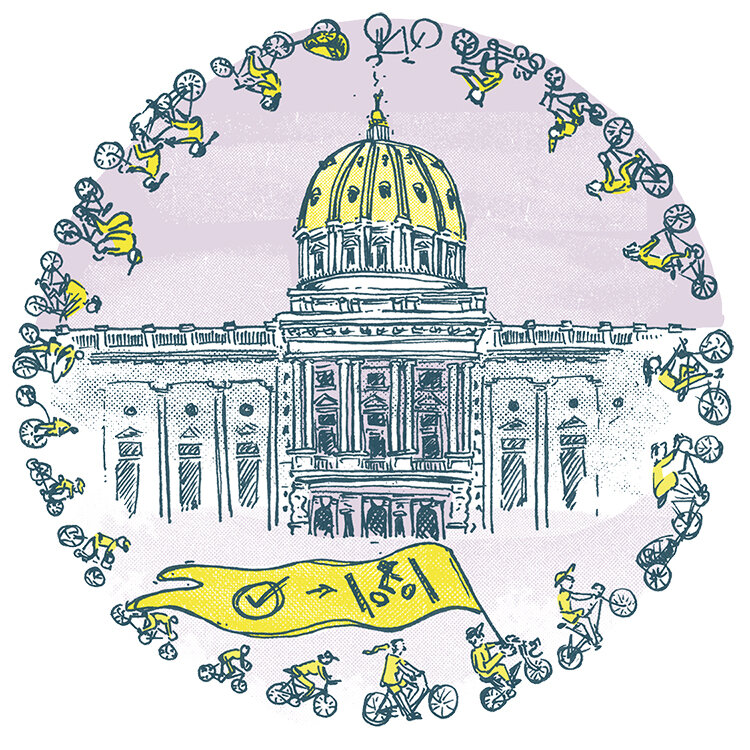Illustration by Sean Rynkewicz
By Randy Lobasso
Urging his colleagues in the state legislature to act swiftly on parking-protected bike lanes and pedestrian plaza legislation, Pennsylvania State Senator Larry Farnese of Philadelphia penned a dire warning June 19.
“If we fail to act … we risk the loss of several major bike lane projects funded for construction this year,” Farnese wrote to the Senate Transportation Committee leadership, senators Kim Ward and John Sabatina. “[W]e must act now in order to decrease the amount of bicycle fatalities in our state, increase the safety of all individuals on our roads, and to make sure we appropriately use taxpayer dollars for future road paving projects.”
That week came and went.
And although the Pennsylvania House of Representatives passed its own bike lane bill, the Senate Transportation Committee failed to bring the legislation up for vote before it dismissed for the summer. The next chance to work on this legislation is later this month, when the legislature reconvenes.
In the meantime, though, because Pennsylvania senators failed to act, streets infrastructure projects around the state have been delayed and more lives were put at risk.
Pennsylvania bike lanes and the law
Let me first say: this shouldn’t be going on.
People who commute by bicycle are very rarely considered when laws are written and infrastructure is installed.
For instance, in Title 75 of the Pennsylvania Vehicle Code, the Pennsylvania Department of Transportation (PennDOT) says motor vehicles must park within 12 inches of a curb. It further clarifies that line-striping and flex posts cannot be interpreted as a curb. This presents a hurdle for parking protected bike lane installations because line striping and flex posts are often used to separate the parked cars from the bike lane.
To install parking protected bike lanes on our city streets would require a legislative change to the vehicle code that specifically says a motor vehicle can park more than 12 inches from a curb. It’s easier said than done given Pennsylvania’s legislature.
The push for legislative action
Cities like Pittsburgh, Lancaster, Harrisburg, and, yes, Philadelphia, have protected bike lane projects that are waiting for state approval. In some cases, like that of Parkside Avenue in West Philadelphia, the bike lane has already been built and striped. The City just needs the go ahead to move parking away from the curb.
Bike groups around the state have not been waiting patiently for such
permissions.
In April, the Bicycle Coalition of Greater Philadelphia, where I work, and Bike Pittsburgh launched a campaign with People for Bikes organizing people all over
Pennsylvania to demand the Senate and House Transportation Committees vote on these bills. In May, the mayors of Philadelphia, Pittsburgh, Harrisburg and Lancaster co-wrote a letter asking for this legislation to come up for a vote.
To give credit where it’s due, the Pennsylvania House Transportation Committee took up the bill in June, and it passed unanimously. It was taken up by the full Pennsylvania House of Representatives and passed nearly unanimously, 200-1, soon after.
To become law, the Senate needed to take up the legislation, pass it, and give it to the governor. But the Senate did nothing. And as streets and roads across the Commonwealth are paved in the summer and fall, the result is that many have been paved without safety improvements.
PA senators return to work on September 23, and advocates will be there lobbying for safe bike lanes.
Streets at risk
In addition to the aforementioned Parkside Avenue, 5th Street, Lindberg Boulevard through Southwest Philadelphia, and the Chestnut Street Bridge, are all ready to install protected bike lanes. The Pennsylvania Senate holding this legislation back not only harms these projects; it also delays others from beginning.
PennDOT and the City of Philadelphia should be able to provide infrastructure that allows anyone, regardless of what mode of transportation they choose, easy and safe access to the streets. This is a political problem, but it’s also a climate problem, a safety problem, a congestion problem and a force holding Philadelphia—and other cities around the Commonwealth—back from reaching their full potential.






